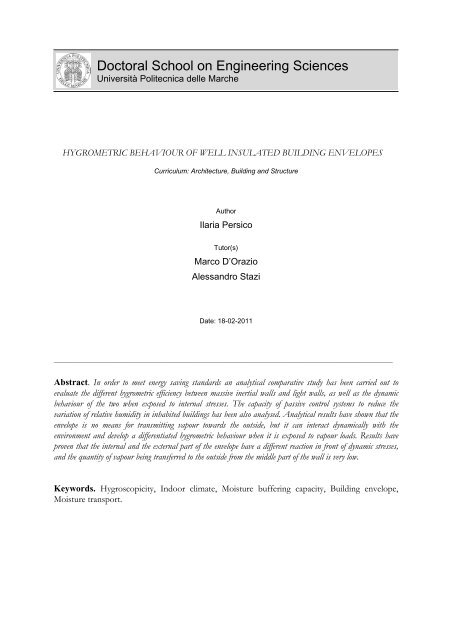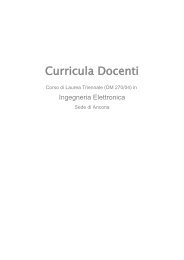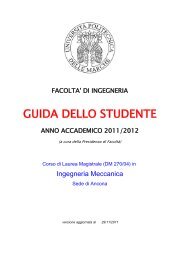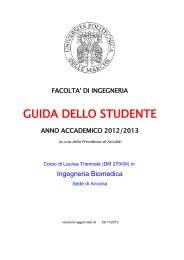IJRA template - Università Politecnica delle Marche
IJRA template - Università Politecnica delle Marche
IJRA template - Università Politecnica delle Marche
Create successful ePaper yourself
Turn your PDF publications into a flip-book with our unique Google optimized e-Paper software.
Doctoral School on Engineering SciencesUniversità <strong>Politecnica</strong> <strong>delle</strong> <strong>Marche</strong>HYGROMETRIC BEHAVIOUR OF WELL INSULATED BUILDING ENVELOPESCurriculum: Architecture, Building and StructureAuthorIlaria PersicoTutor(s)Marco D’OrazioAlessandro StaziDate: 18-02-2011_______________________________________________________________________________________________________________Abstract. In order to meet energy saving standards an analytical comparative study has been carried out toevaluate the different hygrometric efficiency between massive inertial walls and light walls, as well as the dynamicbehaviour of the two when exposed to internal stresses. The capacity of passive control systems to reduce thevariation of relative humidity in inhabited buildings has been also analysed. Analytical results have shown that theenvelope is no means for transmitting vapour towards the outside, but it can interact dynamically with theenvironment and develop a differentiated hygrometric behaviour when it is exposed to vapour loads. Results haveproven that the internal and the external part of the envelope have a different reaction in front of dynamic stresses,and the quantity of vapour being transferred to the outside from the middle part of the wall is very low.Keywords. Hygroscopicity, Indoor climate, Moisture buffering capacity, Building envelope,Moisture transport.
Doctoral School on Engineering SciencesUniversità <strong>Politecnica</strong> <strong>delle</strong> <strong>Marche</strong>
Author : Ilaria PersicoHygrometric behaviour of well insulated building envelopes1 Problem statement and objectivesIn order to comply with the Directive 2002/91/EC on the “Energy Performance ofBuildings” Italian Government has published the decree DLgs 192/05, which has beenthen supplemented with the DLgs 311/06 on “corrective and additional disposition toDLgs 192/05” and more recently with the DPR 59/09. These new regulations focus on theperformances of building systems and of single building components and they are aimed atreducing energy consumption and emissions of polluting gases. While the building materialindustry (especially in the thermo-insulating sector) is promoting natural constructionmaterials of limited environmental impact in the pursue of eco-sustainable buildings and inorder to address the environmental issue, these regulations impose transmittance limits tothe opaque structures, which force designers and constructors to develop “watertight”building components of low vapour permeability. Most of the times this target is reachedusing “super-insulated” or “ultra-light” outside walling, made of very thick insulation. As aresult of this, the function of the building envelope changes radically. The buildingenvelope is no longer responsible for transmitting vapour towards the outside. In fact itscomponents interact with the vapour produced through internal and external conditions ina very differentiated way (that is separately and independently). Its function is furtherendangered by many of the highly hygroscopic natural materials, which are beingintroduced according to the principles of green building. Such materials which can storeand release vapour are often responsible for water collection within the opaque envelope.When the vapour load produced within the environment cannot be dispersed through theenvelope, we reach high values of relative indoor humidity which can deteriorate buildingmaterials and affect the health of the inhabitants.Several international studies have demonstrated that indoor relative humidity is animportant factor which influences environmental thermal and breathing comfort of people,perceived air quality, and heat conduction throughout the elements of the opaque envelope,as well as durability of building components and proliferation of biological organisms suchas fungi, bacteria, and moulds that can be dangerous and toxic to humans. Due to the keyrole covered by relative humidity, recent international studies, mainly carried out inNorthern Europe, have focused on the applications of hygroscopic materials in buildingsand on the capacity they have in moderating variations of indoor relative humidity. Sincethe early 80’s research has been investigating the capacity of porous materials to interactdynamically with indoor air, as hygrometric performances of building materials havebecome basic issues to be faced when analysing or designing new buildings. Accordinglymany modelling and simulation tools have been developed and validated in the field of theintegrated heat-air and moisture transport which takes place among the elements of theenvelope and within the environment. Based on evidence and literature provided throughinternational research [1-10], main purpose of this doctoral thesis is to demonstrate thatvertical opaque envelope cannot transmit vapour, but some of its elements can interactdynamically with the surrounding environment and develop a differentiated hygrometricbehaviour according to the flow of vapour. Secondly this thesis provides detailed dynamicevaluations of the reaction of the opaque envelope when different internal loads areapplied. Besides it also concentrates on the effect that those highly vapour permeableelements of the opaque envelope (brick walling or light padding) have on the quantity ofvapour transmitted and on the quality of indoor climatic conditions. Additionally this thesisDoctoral School on Engineering Sciences 1
Author : Ilaria PersicoHygrometric behaviour of well insulated building envelopesis aimed at identifying the most suitable superficial internal finishing for passive systemswhich control R.H. peaks. These systems are based on the property of vapour absorptionof porous building materials, also known as “Moisture Buffering Effect”.2 Research planning and activitiesThis exclusively analytic study has been carried out by means of dynamic hygrometricsoftwares, able to simulate indoor climatic conditions (temperature and R.H) once havingset outdoor climatic conditions and those of the building envelope. The calculation methodto determine the dynamic load of inner vapour has been given by the creation of asinusoidal law which takes into account the number of people in the room, consideringtheir time of stay and the production of vapour per hour, according to the kind of activitythey are doing. The first step of simulation focused on the evaluation of the dynamichygrometric behaviour of the opaque element in relation to the issues linked to the DLgs.311/06: year’s simulations have been done in order to compare different building solutions(inertial/light). Such solutions differing in presence/absence of mass, insulating technology(more or less hygroscopic), presence of vapour barrier, external climatic conditions, andlevel of air tightness within the building.After having checked the hygrometric functioning of massive and light constructionlayers, keeping the same set of boundary conditions and the same thermal transmittance forthe envelope, the interaction between building envelope and indoor environment has beenanalysed according to the application of different internal dynamic loads (long lastingvapour load (almost one day), heavy vapour load in a short time and medium vapour load).Predictive dynamic hygrometric softwares used (Champs Bees 1.6 + Champs Multizone1.4.1) allowed simulations on the hygrometric behaviour of buildings with a good level ofdetail. Since there are many different parameters affecting the interaction between opaqueelement and indoor environment, the effect of the finishing has been evaluated groupingsimulations according to issue categories, that is: hygrometric separation of the opaqueelement, the role of a more permeable envelope, and the optimisation of the capacity ofstoring and releasing vapour (moisture buffering) in internal finishes made of lime-cementplaster. Hygrometric feedback of well insulated massive/light walls has been theninvestigated, keeping the same thermal transmittance of the envelope, but varying internaldynamic loads and outdoor climatic conditions. Finally it has been analysed the impact ofdifferent kinds of internal finishing (with different “Moisture Buffering Capacity”) whenapplied to traditional single layer with cladding in internal environments exposed to highinternal dynamic vapour loads.3 Analysis and discussion of main resultsAccording to main results of the second step of simulation the external and the internalpart of the opaque envelope do not react the same in front of dynamic stresses. Based onthese results, it has been proposed an average indoor wall thickness which is actuallyaffected by the dynamic phenomenon of vapour storage and release caused by the materialit is made of. Though very small, it has been possible to estimate the quantity of vapourtransmitted to the outside through the middle part of the wall. The study has demonstratedthat the depth of the inner wall, actually interested by the dynamic behaviour of vapourDoctoral School on Engineering Sciences 2
Author : Ilaria PersicoHygrometric behaviour of well insulated building envelopesstorage and release, does not exceed 10-15 mm thickness of traditional inner finishing. Therole of massive and light elements of which the opaque envelope is made has also beeninvestigated, together with its effects on the quantity of vapour released and on the qualityof indoor climatic conditions. Finally, once demonstrated the importance of the internalfinishing layer, the study went on with the parameterization of the hygrometric featureswhich regulate the capacity of internal plaster finishing of storing and releasing vapour.Based on the results obtained, following assumptions can be made:− The amount of vapour flow released through the building envelope is so small that it isalmost nothing if compared to the vapour flow which is generated through internaldynamic loads of vapour and which involves the internal and external plaster;− Outer plaster and insulation for the cladding (only for massive external insulations) areonly affected by those stresses which stems from outdoor climatic changes;− Higher permeability of the insulation within the massive wall with external insulationdoes not influence the behaviour of the envelope. In fact even if thanks to a betterpermeability of the material we get bigger vapour flow within the external insulation, thiscannot actually be released to the outside, then causing a higher water content within themassive material of higher permeability;− Last, changing the hygrometric parameters of vapour storage and release of internalplaster, it has been verified that a high permeable hygroscopic finishing with high vapourpermeability can be useful to keep levels of internal vapour loads under control and todecrease variations of relative humidity. Since these parameters are responsible for thequality of air indoor, it is advisable to foresee such finishing typology.The second loop of simulations has extended the hygrometric analysis to well insulatedbuilding solutions, both massive and light, given the same thermal transmittance but settingdifferent internal dynamic loads and outdoor climatic conditions. These simulations haveproven that each building typology, whether massive or light, and with low thermaltransmittance develops an independent behaviour in front of vapour flows generatedthrough dynamic loads. Basically only a thin layer of the internal surface is influenced bythe different internal loads, whereas the outer part is only affected by outdoorenvironmental conditions. The vapour flow which is transmitted through the central partof the envelope is nothing if compared to the flow we get on surfaces. The wood layeredlight building solution has the same hygrometric reaction of the solution which foreseesinsulation in the interspace, so it has no influence on indoor hygrometric comfort. It hasbeen demonstrated that only those surface finishes which are involved in the process ofvapour storage and release play a significant role in the regulation of indoor relativehumidity, and that despite the well established trend shared among several companiesspecialised in green building, hygroscopic buffer made of wood fibre under the first layerof plaster or plasterboard does not improve either vapour release or dispersion. Among thedifferent materials used for internal finishing it is advisable to chose those which arehygroscopic and more vapour permeable since they regulate the levels of internal vapourloads and limit the variations of relative humidity. For example porous lime and cementplaster is better than water-tight plasterboard. In other words they grant better quality ofindoor air. Wood fibre buffer is useful only if it is 5 cm thick and if it is placed in directcontact with the internal environment. The choice for the right internal finishing can be ofsome help in order to keep maximum levels of vapour pressure under control, especially inthe environments with impulsive vapour production. That is because the moisturebuffering property of the materials has no effect on the average values of relative humidity,but it rather regulates the amplitude and lowers the peaks. Its effect is therefore less evidentDoctoral School on Engineering Sciences 3
Author : Ilaria PersicoHygrometric behaviour of well insulated building envelopesin front of a continuous source of vapour. According to detailed analysis of thehygrometric reaction of surface finishing layers, the surface which is in direct contact withthe indoor environment reacts first and immediately after a vapour dynamic stress isapplied, only then the sub-layers. The velocity of the overall system depends from the kindof load and from the type of material sequence of the layers. The calculation of the actualdepth reached by humidity penetrating into the layered structure provides no clue to thedifferent behaviour of walls, since it is not particularly affected by the different types ofload, and the time variable is not properly considered. It has been also given evidence thatgenerally the materials involved in the phenomenon of vapour storage and release belongto the first two layers and that the right sequence of material layers is important. Since,especially for the light wood padding, the resistive properties of coupled materials are notavailable, the only useful parameter to define general laws is the assessment of the amountof humidity (“Iw”) which is rapidly absorbed and gradually released through one squaremeter of wall.Last simulations have shown that moderate ventilation fosters moisture buffering insurface finishing materials on those walls which are involved in the dynamics of vapourstorage and release, and it provides interesting case-studies on passive regulation of indoorrelative humidity levels. Where we have a discontinuous production of vapour, adsorbentfinishes lower the packs of indoor vapour pressure, especially the maximum values, andtherefore they improve hygrometric comfort. On the contrary in internal environmentswith continuous vapour production, adsorbent finishing behaves just as traditional finishes,as it soaks up vapour but does not release it because of the steady high levels of indoorrelative humidity.4 ConclusionsThis doctoral thesis has provided detailed analysis of hygrometric dynamic interactionbetween environment and building envelope with special focus on indoor environmentalclimatic conditions. Analytic activities have demonstrated the “moisture buffering” capacityfor building materials to keep the levels of indoor relative humidity under control, sincethey are able to store and release vapour within the environment, which tends to becomemore and more air-tight. Further research will be aimed at optimising the functioning ofthe system in front of mechanical ventilation and it will also evaluate the role of furniture inthe reduction of indoor humidity variations and in the preservation of the building heritage.Future research might concentrate on the characterisation and testing (such as durabilitytest) of coupled materials, and investigate combinations between traditional materials andinsulations either of natural origin or of high hygroscopic properties.References[1] Janssen H., Roels S., Qualitative and quantitative assessment of interior moisturebuffering by enclosures, Energy and Buildings, 41, 382-394, 2009[2] Woloszyn M., Kalamees T., Abadie M.O., Steeman M., Kalagasidis A.S., The effect ofcombining a relative-humidity-sensitive ventilation system with the moisture-bufferingcapacity of materials on indoor climate and energy efficiency of buildings, Building andEnvironment 44, 515-524, 2009Doctoral School on Engineering Sciences 4
Author : Ilaria PersicoHygrometric behaviour of well insulated building envelopes[3] Cerolini S., D’Orazio M., Di Perna C., Stazi A., Moisture buffering capacity of highlyabsorbing materials, Energy and Buildings, 41, 164-168, 2009[4] Stekens P., Janssen H., Rode C., Influence of the convective surface transfercoefficients on the heat, air and moisture (HAM) building performance, Indoor and BuiltEnvironment 18,3,245-256, 2009[5] Abadie M.O. Mendonca K.C., Moisture performance of building materials: frommaterial characterization to building simulation using the Moisture Buffer Value concept,Building and Environment ,44, 388-401,2009[6] Ramos N.M.M., Delgado J.M.P.Q., de Freitas V.P., Influence of finishing coatings onhygroscopic moisture buffering in building elements, Construction and Building Materials,24, 2590-2597,2010[7] M. Salonvaara, T. Ojanen, A. Karagiozis; Indoor air humidity variations and its effectson the moisture performance of building envelope; Eighth International IBPSAconference, Eindhoven, Netherlands,2003[8] Kurnitski J., Kalamees T., Palonen J., Eskola L., Seppanen O., Potential effects ofpermeable and hygroscopic lightweight structures on thermal comfort and perceived IAQin a cold climate, Indoor Air 17, 37-49, 2006[9] Stephane Hameury, Moisture Buffering capacity of heavy timber structures directlyexposed to an indoor climate: a numerical study, Building and Environment 40, pp.1400-1412, 2005[10] Osanyintola, O. F., Simonson, C.J. : Moisture buffering capacity of hygroscopicbuilding materials: Experimental facilities and energy impact. Department of MechanicalEngineering, University of Saskatchewan, Energy and Buildings n.03.026, 2006.Doctoral School on Engineering Sciences 5
















